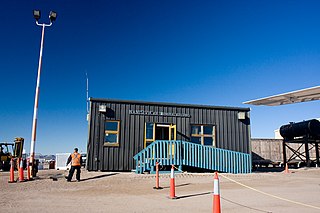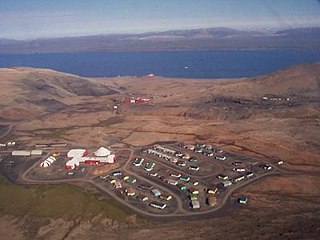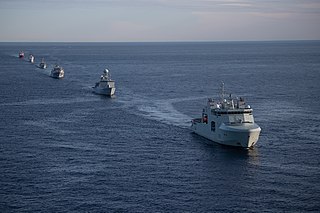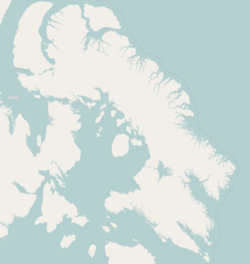
Iqaluit is the capital of the Canadian territory of Nunavut, its largest community, and its only city. It was known as Frobisher Bay from 1942 to 1987, after the large bay on the coast on which the city is situated. In 1987, its traditional Inuktitut name was restored.

Pond Inlet is a small, predominantly Inuit community in the Qikiqtaaluk Region of Nunavut, Canada, located on northern Baffin Island. To the Inuit the name of the place "is and always has been Mittimatalik." The Scottish explorer Sir John Ross had named an arm of the sea that separates Bylot Island from Baffin Island as Pond's Bay, and the hamlet now shares that name. On 29 August 1921, the Hudson's Bay Company opened its trading post near the Inuit camp and named it Pond Inlet, marking the expansion of its trading empire into the High Arctic.

The Royal Canadian Navy is the naval force of Canada. The RCN is one of three environmental commands within the Canadian Armed Forces. As of 2021, the RCN operates 12 frigates, four attack submarines, 12 coastal defence vessels, eight patrol class training vessels, two offshore patrol vessels, and several auxiliary vessels. The RCN consists of 8,570 Regular Force and 4,111 Primary Reserve sailors, supported by 3,800 civilians. Vice-Admiral Angus Topshee is the current commander of the Royal Canadian Navy and chief of the Naval Staff.

Arctic Bay is an Inuit hamlet located in the northern part of the Borden Peninsula on Baffin Island in the Qikiqtaaluk Region of Nunavut, Canada. Arctic Bay is located in the Eastern Time Zone although it is quite close to the time zone boundary. The predominant languages are Inuktitut and English. Arctic Bay is notable for being the birthplace of the former Premier of Nunavut and, as of 2021, the Commissioner of Nunavut, Eva Aariak. It is the northern most public community in Canada, not formed from forced relocation.

Resolute or Resolute Bay is an Inuit hamlet on Cornwallis Island in Nunavut, Canada. It is situated at the northern end of Resolute Bay and the Northwest Passage and is part of the Qikiqtaaluk Region.

Canadian Forces Station Alert, often shortened to CFS Alert, is a signals intelligence intercept facility of the Canadian Armed Forces at Alert, in the Qikiqtaaluk Region of Nunavut, Canada.

There are an estimated 850 km (530 mi) of roads and highways across the Canadian territory of Nunavut, which is the only province/territory not connected by road to other parts of Canada.

Nanisivik Airport, formerly, was located 8 nautical miles south of Nanisivik, Nunavut, Canada, and was operated by the Government of Nunavut. Although Nanisivik Mine closed in September 2002, the airport was in operation until 2011 and served the community of Arctic Bay. This was due to the small size of Arctic Bay Airport. However, on January 13, 2011, First Air transferred all scheduled air services to Arctic Bay's newly-expanded airport.

Resolute Bay Airport is located at Resolute, Nunavut, Canada, and is operated by the government of Nunavut. It is one of the northernmost airfields in Canada to receive scheduled passenger airline service.

Nanisivik is a now-abandoned company town which was built in 1975 to support the lead-zinc mining and mineral processing operations for the Nanisivik Mine, in production between 1976 and 2002. The townsite is located just inland from Strathcona Sound, about 20 km (12 mi) east of the community of Arctic Bay in the Canadian territory of Nunavut.

Nunavut is the largest and northernmost territory of Canada. It was separated officially from the Northwest Territories on April 1, 1999, via the Nunavut Act and the Nunavut Land Claims Agreement Act, which provided this territory to the Inuit for independent government. The boundaries had been drawn in 1993. The creation of Nunavut resulted in the first major change to Canada's political map in half a century since the province of Newfoundland was admitted in 1949.

Nanisivik Mine was a zinc-lead mine in the company town of Nanisivik, Nunavut, 750 km (470 mi) north of the Arctic Circle on Baffin Island. It was Canada's first mine in the Arctic. The mine first opened on 15 October 1976 and permanently closed in September 2002 due to low metal prices and declining resources. Mine reclamation began in April 2003. It was one of the most northerly mines in the world.
The Mary River Mine is an open pit iron ore mine on Inuit Owned Land (IOL) operated by the Baffinland Iron Mines Corporation (BIMC), in the Mary River area of the Qikiqtaaluk Region, on Baffin Island, Nunavut, in the Canadian Arctic Archipelago. As of 2021, Mary River mine operation consists of an open-pit mine, two work camps for hundreds of workers, a tote road—from the Mary River site to Milne Inlet—and a port infrastructure at Milne Inlet. According to a 4-year study published in 2008, the Mary River Mine, with its four massive iron ore deposits of 65-70% pure iron ore was "one of the most promising undeveloped iron deposits on the planet". It was not until technological advances were in place in 2010, and the market for iron ore had dramatically increased that sizable financial backing for the high cost of development in a remote region known for its inhospitable climate, was available. The mine began operations in 2014, and the first shipment to Europe arrived in 2015. Baffinland is currently planning on expanding the mine. In February 2021, a group of Inuit hunters blockaded access to the mine for a week to protest the expansion.

Harry DeWolf-class offshore patrol vessels are warships of the Royal Canadian Navy (RCN) built within the Government of Canada Arctic and Offshore Patrol Ship (AOPS) procurement project, part of the National Shipbuilding Procurement Strategy. In July 2007 the federal government announced plans for acquiring six to eight icebreaking warships for the RCN.

Operation Nanook is an annual sovereignty operation and manoeuvre warfare exercise conducted by the Canadian Armed Forces in the Arctic. Sovereignty patrols in the Canadian Arctic Archipelago and northern Canada are conducted by the Canadian Rangers, Canadian Coast Guard in tandem with the Royal Canadian Mounted Police. The exercise portion is intended to train the different elements of the Canadian Armed Forces to operate in the Arctic environment.
Polaris zinc mine was a former underground mine on Little Cornwallis Island in the Canadian territory of Nunavut. The Polaris zinc mine was located 1,120 km (700 mi) north of the Arctic Circle, and 96 km (60 mi) north of the community of Resolute. The Polaris mine closed in July 2002 following more than twenty years of zinc production.

Irving Shipbuilding Inc. is a Canadian shipbuilder and in-service support provider. The company owns industrial fabricators Woodside Industries in Dartmouth, Marine Fabricators in Dartmouth, Halifax Shipyard as the largest facility and company head office as well as Halifax-based Fleetway Inc., an engineering and design, support and project management firm.
The Bathurst Inlet Port and Road Project is a plan to build an all-weather road from Bathurst Inlet in Nunavut to a complex of mines that are approximately equidistant between Bathurst Inlet and Yellowknife, NWT. There are no paved roads between Yellowknife and the mines, so they have relied on shipping supplies to the mines over winter-time ice roads. However, in 2005, there was a particularly warm winter, and the ice roads weren't safe for a long enough period to bring in supplies.


















